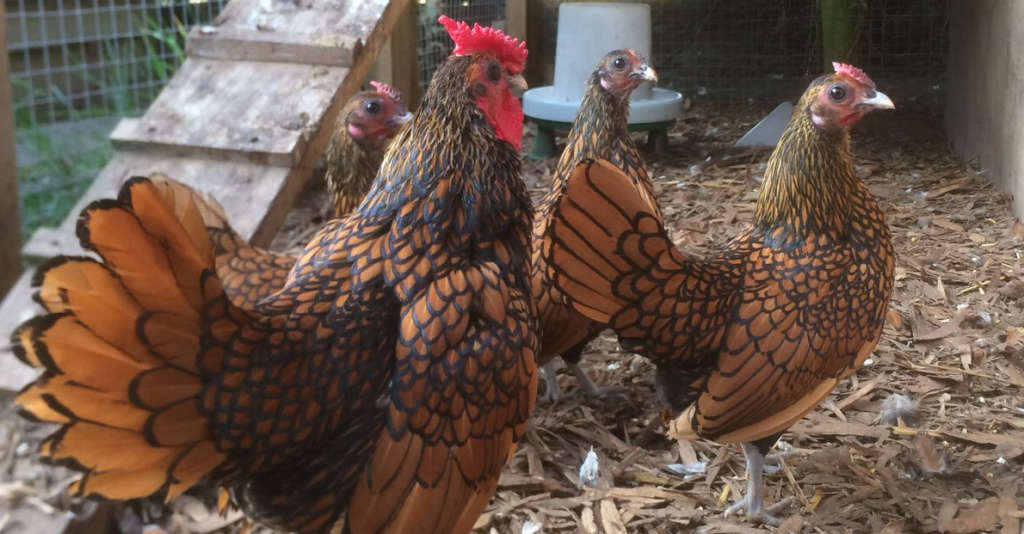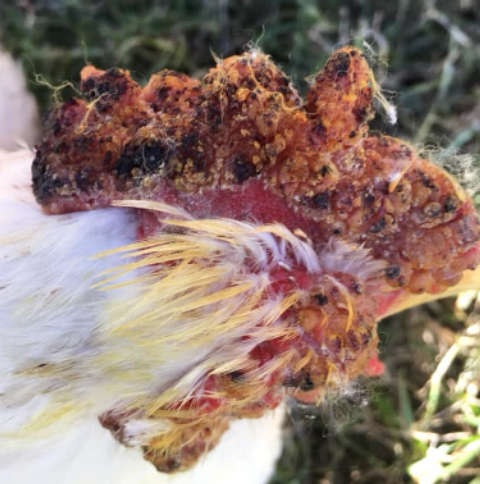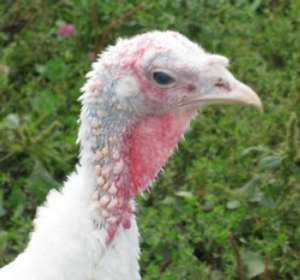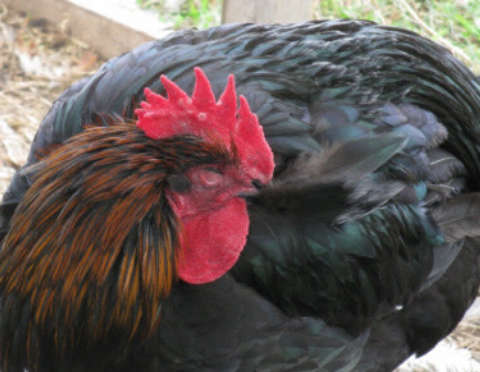Fowl pox in chickens and how to treat it.

What is Fowl Pox in chickens?
Fowl pox or Avipoxvirus in chickens, turkeys and other poultry is a viral condition that spreads slowly because of it's long incubation period. It has two types that both produce lesions, the cutaneous form which is so often noticed by keepers on the comb and wattles and the diptheric form which produces lesions in the mouth and airways and is seen less often by backyard poultry enthusiasts. The virus is sturdy and can persist for months in the environment in ideal conditions.
Table of Contents
- What is Fowl Pox in chickens?
- What are the symptoms of Fowl Pox?
- There are two types of Fowl Pox virus:
- How is Fowl Pox spread?
- Will all chickens catch Fowl Pox?
- How to treat Fowl Pox in chickens:
- Fowl Pox incubation period:
- Is Fowl Pox fatal to chickens?
- Can chickens catch Fowl Pox more than once?
- How long does Fowl Pox last?
- Are ther home remdies and natural treatments for Fowl Pox?
- Fowl Pox prevention:
- Fowl Pox vaccine:
- Is Fowl Pox contagious to humans?
Fowl Pox is not a notifiable disease and not as awful as it sounds, but requires careful management and is very important as a consideration if you show your birds. As it is a virus antibiotics are not required unless there is a secondary infection.
If you suspect the disease immediately stop sharing, selling or showing birds. Notify anyone who has bought birds from you in the previous 2 months.
It was in the late fall after the worst hot damp summer I can remember and I noticed odd scabs on the combs of our birds. Both cockerels and pullets were starting to mature and were squabbling a bit but not really fighting enough to cause these random mostly round scabs. It wasn't from new birds as far as I can tell, I bring in very few adults and they get quarantined for 30 days minimum, and none of them got ill.
Below: A bad case of Fowl pox.

Above is a young cockerel showing fowl pox and the lethargy often seen in the first few days and the beginning of the distinctive black scabs on the comb.
What are the symptoms of Fowl Pox?
The common signs of fowl pox in chickens and turkeys are:
- Chickens will be quiet, fluffed up and uncomfortable.
- May stop eating and /or drinking.
- Lesions the look like black pinhead scabs following after white pustules or sores on un-feathered areas.
- Respiratory symptoms like difficulty breathing.
- Red and inflamed mucous membranes and / or eyes.
- Depressed or a stop in egg production.
- Round black ashy scabs on the comb that seem to remain forever.
- Flat yellow lesions in the mouth.
As soon as you suspect that one or more of your chickens you should isolate those birds however if the whole lot is infected and looking ill then treat them all to be safe.
It is a somewhat cruel condition, by the time the symptoms show the bird has been infected for some time and has begun shedding the virus.
We observed early on they get the fluffed miserable look, then once the scabs show up and darken, they seem to behave more normally. But how do you know if they have it for sure?
It has a long incubation period of between 4-22 days (average 6 to 8), and the lesions if present can look like scabs and cuts to the comb, commonly seen when the young roosters are sparring, though not usually as a thin line like those scratches. This makes it pretty well impossible to detect until a pattern is seen.
In all outbreaks, wart-like lumps are visible on many birds, which is a reliable guide to diagnosis. I have only ever seen one lesion on a leg or foot out of a few hundred birds and I never managed to get a photo but a whole individual scale was replaced by something that looked like a pustule that later dried to a large scab.
Dry pox is the most common and develops as wart-like eruptions. Fleshy pale lumps form yellow pimples that may enlarge and run together to form masses of yellow crusts. These scabs darken and fall off in about a week. They occur mainly on the comb, wattle and face but can occur on other parts of the body. The dry form is relatively easy to diagnose because of the profusion of round black scabs that appear in the latter stages.
Wet pox forms as ulcerous cheesy masses in the mouth, nose and sometimes throat areas, which can interfere with eating and breathing. Birds with wet pox will appear unwell and in some cases may die.
Knowing your birds and their usual behaviour will help. If they roosters spar and fight a lot, maybe those marks are just scratches. If you see a roundish scab and there was not wound there couple of days before, it may be pox. Looks for usually perky birds standing around with eyes closed and head under wing. Pox may be very light coloured at that early stage.
There are two types of Fowl Pox virus:
Both types of the fowl pox virus are very painful conditions and any bird will be in considerable discomfort.
The Wet Form: Chickens affected with the wet form of Fowl Pox will also develop lesions but these affect the inside of an infected bird’s mouth, throat and trachea or on the conjunctiva of a bird’s eye. The trachea may appear reddened and inflamed and the lesions can show as yellow masses or lumps.
The wet type of avipox virus is the more serious form of the two due to the fact that as the lesions grow and develop they may block air coming into the trachea causing suffocation and birds may not be able to eat or drink causing eventual death.
The Dry Form: Chickens affected with the dry form of Fowl Pox will develop small bumps or raised areas which eventually pop open and secrete pus which hardens into a crusty scab very similar although smaller than the pock marks humans get. These lesions occur on any non-feathered areas such as combs, wattles, beaks, eyes, earlobes, and legs.
Below: A rooster with dry Fowl Pox.

This rooster only had a handful of pock marks and didn't seem to suffer much at all.
Infected chickens will feel pain, discomfort and irritation. The impact of this virus may cause secondary side effects of weight loss and a decrease in egg laying.
Lesions occurring on a chicken’s eyelid may cause such discomfort that a bird may find it difficult to open their eyes. The dry form is the milder form of the two and usually does not end in death.
Both forms can appear simultaneously and this is more likely to be fatal.
Scratching of the pock marks can lead to further infections so this need to be watched out for.
How is Fowl Pox spread?
Fowl pox is found the world over amongst poultry and wild birds and chicken keepers need to be vigilant. There are several ways the virus can transmitted from bird to bird or between flocks. It is easy to transmit and the virus survives for a period of weeks or more in chicken shed litter or dust baths and the like.
Fowl Pox is spread by:
- An infected chicken can shed pox scabs which are picked up by other hens or through secretions.
- You can spread it between birds with poor hygiene or by going to see a friend who has chickens when yours are infected.
- Re-using a needle used to treat an infected bird.
- The virus that causes fowl pox can be spread by biting insects and even just flies travelling from one chicken to another. Mosquito's can spread the virus via bites for 30 days after biting an infected bird.
- Entry through wounds or scratches or even through the mucous membranes in the birds airways and mouth.
It requires a wound or mucous membrane to infect the chicken, It can't enter through the skin.
Will all chickens catch Fowl Pox?
So will it spread through your entire flock - Possibly, Quarantine may protect the healthy birds, it depends how long it has been ill and roaming amongst the flock. You may want to consider letting the birds catch it and a natural immunity will follow.
The ones that recover best are those birds that in good condition with supportive care.
How to treat Fowl Pox in chickens:
The first thing you should do after an outbreak is:
- Thoroughly clean and disinfect the coop and run area.
- Move them if you can.
- Empty the dust baths and refill with fresh sand and diatomatous earth or wood ashes.
- Make sure the surfaces are properly cleaned and if necessary rub them down with sandpaper and retreat the wood.
- Give supporting treatments to make the chickens more comfortable.
- Quarantine sick birds well away from healthy ones.
The ethics of what to do if your flock have fowl pox is going to be different for everyone.
I imagine some people sell birds with pox with neither the knowledge that they have this or a thought for it. Others may seek veterinary treatment or cull the whole flock.
As it is viral and exists the world over I decided to just live with it and vaccinate my chicks. I have free range rare breeds so barrier methods would be hugely expensive.
Turkeys can catch this too and the wild turkeys may have been the source. Here's some pictures of our mild dry pox. Hopefully this will help people identify it in their flocks if they are wondering if their chickens have it. When I was doing my research for our outbreak, there were only pictures of birds covered with pox.
Fowl Pox incubation period:
The incubation period of fowl pox averages 4-10 days but it can be longer.
The first symptom is often listlessness or stood about all fluffed up. In my experience this usually last about 3 days.
Lesions, Nodules (wet type) or pustules appear 6-10 days after infection. Firstly as weeping sores that scab over in a characteristic round scab.
Scabs and respiratory symptoms clear up in 3-4 weeks in simple cases.
An individual chicken should recover in 4 to 5 weeks but it may take a flock 3 to 4 months to get over it.
Is Fowl Pox fatal to chickens?
Mortality is usually low in affected flocks. Reduced egg production and poor weight gains are the greatest impacts. Expect losses to be between 1% and 10% of the flock. Young, old or already sick birds or those with parasites will likely succumb.
This turkey below has quite a bad case, you can see the white lesions all down the neck and on the back of the head but she recovered just fine in time.

Our birds were OK for the most part as they seemed to get a mild version of the dry pox. I lost one bird as far as we know though it may have been from something secondary, which is common, parasites and respiratory things take take hold as their immune system is working overtime.
It is not a reportable disease that requires culling etc, but it involve extra care and vigilance for secondary problems. Opportunistic Mycoplasma and Infectious Bronchitis that the birds may already be carrying. Or parasites, worms, mites lice may claim a few victims.
Can chickens catch Fowl Pox more than once?
Possibly, and apparently some birds remain carriers. Any second dose is likely to be very mild and short lived as this is normally the way with viruses.
It is a viral condition that spreads slowly through a flock. Some sources say they are immune and non-contagious after it has passed and a couple saying they do remain carriers and I am still not 100% sure, it may depend on the individual bird.
If it helps I have never had it come back and never seen it come back a second time when I have seen other cases.
Other symptoms I have read about are depressed egg production for a few weeks if started. It can take a while for the condition to run it's course through a flock (months).
I had hoped for a vaccine to prevent spreading to the others, as it is a slow spreading disease. In the end I chose to let the disease run it's course and vaccinate future chicks.
How long does Fowl Pox last?
The duration of the Fowl Pox virus is probably 14 days for mild cases and 5 weeks for severe. If an entire backyard flock is infected, the duration can extend for 3 months or more. Most chickens will be immune following recovery period although some may be carriers.
Are there home remedies and natural treatments for Fowl Pox?
There are only home remedies and natural treatments unless a secondary problem crops up.
There is unfortunately no known cure for fowl pox. If you are quick you can lessen the effect on your flock by vaccinating birds that are not yet sick. Once more than one fifth of the chickens are infected it is unlikely to be of any help.
Treatment of this disease is of little value as lesions normally heal on their own within 4 weeks. In severe cases, it may be necessary to remove scabs and treat with antiseptics. Consult a veterinarian for treatment advice.
If that is what you have the birds may need feeding soft food and water by hand to get them through the worst week.
Bird can be given supplements and vitamins in water and may need soft food. Grated hard boiled egg is probably the best thing you could give your sick chickens. A few warm green peas cooked from the freezer is soft enough for them to get down easily. Cod liver oil is useful and can be used sparingly.
Treatment is good care, keeping the flock comfortable and keeping the eyes and mouth clear so they can eat and drink.
Mine seemed to get over the worst of it relatively quickly.
Fowl Pox prevention:
An ounce of prevention is worth more than a pound of cure. The first thing to do is isolate all new birds for at least 30 days before allowing them to mix.
Practise proper bio-security especially when travelling between flocks.
Prevention of fowl pox is through a combination of vaccination and reducing exposure to mosquitoes, which can be done by screening sheds and removing mosquito habitats.
Avipoxvirus is resistant and long lived especially in mild conditions. Wild turkeys can carry the virus.
Check your flock regularly for scratches and wound where the infection might enter and treat as necessary.
Fowl Pox vaccine:
As with all conditions prevention is better than any cure.
Vaccination probably will not help a flock that is already infected as it takes 2 to 3 weeks for the vaccine to work properly.
The aim of vaccination is to give birds a mild amount of pox so that, after recovering, they are immune to reinfection. Protection becomes effective 2-3 weeks after vaccination.
The vaccine should be given twice, once at 1-2 weeks of age and then a second dose at 12-14 weeks old. Yearly boosters may also be useful.
Below: A cockerel starting to show the first signs of Fowl Pox.

Only healthy, well-nourished birds should be vaccinated. When vaccinating young chicks, husbandry must be excellent or the chicks may suffer severe reactions.
Is Fowl Pox contagious to humans?
No. Neither forms of fowl pox are contagious to humans or other animals. You should still follow hygiene procedures and good bio-security though as you can pass it from flock to flock or infect more of your own birds.
Can you eat eggs or chicken from chickens with fowl pox
Fowl Pox isn't passed through eggs at all and they are safe to eat. The same is true with meat from infected birds. Although unsightly, avian pox does not pose a threat to humans and animals infected can be safely cleaned and consumed.
